
Dynamic and Optical Characterization of Dusty Plasmas for Use as
Solar Sails
Robert Sheldon1, Edward Thomas, Jr.2, Mian
Abbas3, Dennis Gallagher3, Mark Adrian3
and Paul Craven3
1The University of Alabama in Huntsville, Huntsville,
AL 35899
2Auburn University, Auburn, AL
3National Space Science and Technology Center, 320
Sparkman Dr, Huntsville, AL 35805
October 2001
Abstract
Solar sails presently have mass loadings about 5 gm/m2, which
when including the support structure and payload, could easily average
to > 10 gm/m2. For realizable spacecraft, the critical
parameter is the total mass / total area, which when combined with the
reflectivity, directly give the true acceleration. We propose that dusty
plasmas trapped in a ``mini-magnetosphere'' (Winglee et al. JGR 2000)
can produce a solar sail with a total mass loading < 0.01
gm/m2, and reflectivities of ~1%. This configuration provides
an acceleration equivalent to a standard sail of 95% reflectivity with
< 1gm/m2. Thus, dusty plasma sails represent a potential
replacement for thin film technology.
However, the physics of dusty plasma sails is not mature. Several
important questions need to be resolved in the laboratory before a large
scale effort is warranted. Foremost among these questions are, what is
the largest force a dusty plasma can sustain before it demagnetizes and
separates from the binding magnetic field? What are the charging
properties of dust under solar UV conditions? What is the light
scattering cross section for the dust? What is the optimum dust grain
size for magnetization and scattering? What are the optimum dust grain
materials?
In this paper we outline what we know about dusty plasmas, and what we
are hoping to learn from two existing dusty plasma experiments at the
National Space Science and Technology Center (NSSTC) and at Auburn
University. In the Dusty Plasma Lab at NSSTC, we have a force balance or
Paul trap to suspend a single dust grain either in air or in vacuum.
With this arrangement, we determine the forces on a dust grain
illuminated by a laser, and measure directly the ratio of light pressure
to grain size and composition. At Auburn University, and now also in the
Spinning Terrella Lab at NSSTC, we can observe the collective properties
of a dusty plasma, and study whether we can suspend a "Saturn's ring" of
dust around a rare-earth magnet.
Introduction
The concept of a sail is so ancient as to defy attribution, yet so
modern that it is constantly re-engineered and redefined. For example,
the parasail is a relatively new invention that remakes the simple sail
into an airfoil, and thereby spawned a whole new sport. If we are
permitted to broaden the scope of a sail to include any device that
couples momentum from the atmosphere, we might be able to include
sailplanes and autogyros. In exactly the same way, if the definition of
solar sails were broadened to include any device that couples spacecraft
momentum to sunlight, we would be able to include magnetic balloons and
plasma sails, which may do for solar sailing what parasails did for
parachutes.
The first recorded occasion when mankind could the ground and took to
the air might be considered when the Montgolfier brothers sent a sheep
up in a hot air balloon in the 1783. Balloons played an important role
in warfare 100 years before aircraft, being used by both sides in the
Civil War as forward observation posts. Even today, ambitious
entrepreneurs are attempting to fly dirigibles equipped with cell phone
antennas 10 miles above a metropolitan area and thereby cover 10,000
square miles with one ``tower". So we see that balloons fill two roles:
they are often the first steps into conquering new territory, and they
occupy some specialized niches much more effectively than the more
versatile, higher technology aircraft.
These are the same two roles that magnetic ballooning fills with respect
to solar sails. Solar sails are undoubtedly high technology. Materials
that are incredibly thin and light have to be deployed over square
kilometers of area and stretched to mirror smoothness. While great
strides have been made in materials the long term survival of such
fragile films, and the deployment of a large sail are still areas
needing work. Knowledgable estimates suggest 5-10 years for the
deployment of a 100 meter sail that will act as a testbed for future
work. In light of the real technological hurdles facing solar sails, is
there an easier way to harness the promise of infinite Isp solar
propulsion? Yes, if one is willing to accept some limitations that come
with the great simplification of ballooning.
Robert Winglee of the University of Washington has proposed and recieved
funding from the NIAC to develop the concept of magnetic ballooning,
which he prefers to call ``M2P2'' for mini-magnetospheric plasma
propulsion (Winglee, JGR 2000). Winglee used a computer code for plasmas
that he had developed over the past decade to show that a magnetic field
can be inflated by a plasma to many times its original size. Then when
this inflated magnetic field is placed in the supersonic solar wind, the
wind transfers momentum to the magnetic field which accelerates at a
constant rate until it approaches the speed of the solar wind, about 400
km/s. One convenient feature of his balloon is that it expands as it
gets further from the sun, much like a weather balloon expands as it
rises through the atmosphere, so that unlike a solar sail, a balloon
experiences a constant force at all distances from the sun. This
theoretical model has been tested with a scale model placed in a 30 ft
vacuum chamber at MSFC, providing the first demonstration of the
inflation of a balloon, and the deflection caused by hitting the balloon
with a simulated solar wind. In figure 1 we show an artist's
rendition of such a satellite employing a dusty plasma sail to
rendezvous with Mars.
Fig 1a: Engraving of Montgolfier balloon.
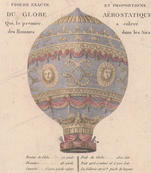
Fig 1b: An artists concept of a plasma sail en route to Mars.
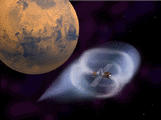
The principle of ballooning is simple, but involves some tradeoffs that
require some quantitative discussion. The strength of sunlight at the
Earth's orbit is about 1.4 kW/m2. Einstein demonstrated that
light is a particle and therefore has a momentum given by p = E/c.
This means that the intensity of sunlight given above can be converted
into a pressure (=force/area) by dividing by the speed of light, c.
Working in SI units, that would be 4 mu Pa of pressure generated by
light on a black sail. But in addition to sunlight, the sun is
evaporating, sending out heated hydrogen and helium in a supersonic
radial flow known as the solar wind. The solar wind, like the Earth's
wind, varies in speed from 300-1000 km/s, but on average is about 400
km/s. The density is quite low, however, between 1-10 atoms/cc, which
has an average around 3/cc. So if we have a square meter of area
intercepting this flow, the pressure exerted by the solar wind would be
the momentum of all the particles in a volume 1m2 x 400 km,
or 1.2x1012 proton x 1.67x10-27 kg/proton x 400
km/s = 0.8 nPa. Since the solar wind is about 5% Helium, it adds about
25% to the mass density, which makes this a convenient round number of 1
nPa for the pressure exerted by the solar wind. The result of this
calculation is that solar wind is about 4000 times less effective than
sunlight in pushing a sail.
This calculation is why the solar sail calculations rarely add the
forces due to the particles. A magnetic balloon, on the other hand,
intercepts most of the solar wind pressure and very little of the
sunlight pressure. So why would anyone prefer a magnetic balloon? Well,
when calculating the acceleration of a spacecraft, it isn't the pressure
that is needed, it is the total force divided by the total mass. If a
solar sail is 1000 times heavier than a balloon of the same size, then
even if it does experience more pressure, its acceleration is less.
Worse than that, as the sail leaves the sun, its acceleration drops with
decreasing light intensity whereas a balloon keeps a constant
acceleration (theoretically at least out to the heliopause, which is
beyond the orbit of Pluto).
Can we estimate the size/mass ratio of a balloon? This is the
calculation Winglee has done. He argues that a simple magnetic field,
say, from a permanent magnet, doesn't make much of a balloon. However,
when plasma is injected into that magnetic field, much the way Jupiter
fills its magnetic field with plasma, then the size of the balloon is
increased 10 or 100 times. (A magnetic field filled with plasma was
called a ``magnetosphere'' when it was discovered around the Earth 40
years ago, which accounts for Winglee's terminology). For example, if
we could see Jupiter's magnetosphere from Earth, it would be larger than
the full moon, being about 100 times larger than Jupiter itself.
Therefore, Winglee argues, we can build a spacecraft that inflates a
magnetic balloon much larger than the spacecraft itself. Winglee
estimates that a 30 km wide balloon can be inflated with ``commercial
off-the-shelf'' (COTS) components on a 1-meter sized spacecraft that
weighs about 500 kg. In solar sail terminology, that is <0.001
gm/m2, which is a very low mass-loading. Even with the 1/4000
times weaker solar wind pressure, the resultant acceleration is still
equivalent to a 10 gm/m2 solar sail/spacecraft.
Are balloons then, destined to be surpassed by solar sails when sails
can finally be made with mass loading < 10 gm/m2? Not
necessarily, for if magnetic balloons can tap, if ever so slightly, into
the sunlight pressure, they can increase their exfficiency up to 4000
times, in essence, becoming a solar sail. Imagine for a moment, that
there exists a gas that is bright yellow when it is ionized. If the
magnetic balloon were inflated with this yellow plasma, then it would
not only deflect solar wind, it would deflect sunlight. Perhaps not all
of the sunlight, but even 1% of the sunlight would be a factor of 40
more acceleration for the balloon. That is, a 1% opaque plasma filling a
500 kg balloon to a diameter of 30km would have an equivalent mass
loading of 0.1 gm/m2. Not only does this surpass the
expectations of the AO, but such a plasma sail would be easily deployed,
resistant to tearing, compactly stored, and radiation hard. This then,
is the purpose of this paper: to investigate the potential for magnetic
balloon materials that are opaque to sunlight, which we refer to as
``plasma sails''.
Plasma Sails
It is well known that if a solar sail can specularly reflect sunlight,
it not only gains a factor of 2 in momentum, but it gains the ability to
``tack'', or generate thrust at an angle from the radial. Despite this
advantage, one of the more promising solar sail candidates at the
present is the black carbon-fiber sail, that can only absorb sunlight,
and therefore cannot ``tack'' efficiently. It is promising because of
its robust performance with respect to heat, tearing, deployment and
mass-loading. It is instructive to examine microscopically how a
carbon-fiber sail accomplishes this feat. It replaces a 2-D film with a
3-D mesh of carbon fibers which have on average, a smaller diameter than
the thickness of the 2-D film. Yet it is remarkably robust, primarily
because of its 3-D structure. Somehow an open mesh of mostly empty space
can be stronger than a 2-D solid structure of the same weight.
In the same way, we view a plasma sail as an open mesh of mostly empty
space, held together by long-range electrostatic and electromagnetic
forces, rather than chemical bonds. In this sense, a plasma sail is just
the extrapolation of a carbon sail to infinitesimal fibers. The
components of a plasma are an even mixture of ions and electrons that
form an electrically neutral fluid. The ions can be simple atoms that
have lost a few electrons, or they can be massive particles with a net
charge of many hundreds of electrons, or an admixture of both. The
response of the plasma to a force depends on its magnetization as well
as ion's mass. The properties of a plasma, then, are crucial in
determining whether a plasma sail can withstand the pressure of sunlight
and solar wind without ripping it to the shreds we see in comet tails.
The simplest plasma sail one can imagine is an atom that when ionized,
still absorbs or scatters sunlight. All ions that are not fully
stripped, that is, having at least one electron left, possess this
property. Since the solar wind is composed of mostly fully stripped
H+ and He++ it remains invisible. But we could use
for example, Ba+, or Li+ ions that scatter some
characteristic frequency of light, which are the principle means for
coloring fireworks. The trouble with using a colored ion for the
plasma, is that it absorbs such a narrow part of the solar spectrum,
resulting in a small efficiency increase. Ideally, one would like a
``black'' ion, one that absorbs all the sunlight. A viable alternative
is to use molecules or clusters that form charged dust grains, or dusty
plasmas. These plasmas occur naturally around comets or within Jupiter's
magnetosphere, where they can be observed with telescopes. The field of
dusty plasmas is brand new and many questions have yet to be answered,
but we can still draw some conclusions from observations of comets.
Comets have two tails, a dust tail and a plasma tail. The dust tail
somewhat follows the orbit of the comet, whereas the plasma tail is
stretched radially in the direction of the solar wind. Indeed, these
observations were the first indication of the existence of the solar
wind. But this indicates that the dust does not stick to the plasma, it
is not contained by the draped magnetic fields of the comet. If we are
going to make a ``black'' magnetic balloon out of dusty plasma, we must
find a way to get the dust to stick.
Fig 2a: The dusty plasma experiment (DPX) at Auburn University.
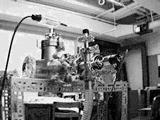
Fig2b: Dusty Plasma Lab at MSFC/NSSTC.
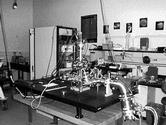
These then form the two prongs of an experimental approach towards
developing second generation plasma sail materials: an investigation of
``sticky'' dusty plasmas, and an investigation of ``black'' plasma
materials. The first problem, of maintaining the integrity of a dusty
plasma against an external force, is very similar to the problem of
dusty plasma levitation against the pull of gravity, an experiment that
has been addressed by Edward Thomas Jr at Auburn University. The second
problem, of quantifying the scattering coefficients of a dusty plasma,
has been addressed by Jim Spann and Mian Abbas of NASA/MSFC, albeit for
selected dust types. In figure 2 we show the experimental
setups of both groups. We propose to augment both experiments to measure
candidate dust types for a plasma sail, measuring the radiative transfer
functions for individual dust grains at MSFC, while examining their
collective behavior at Auburn University.
``Sticky'' Dusty Plasma Theory
In a dusty plasma, the usual plasma (ionized gas) environment of ions,
electrons, and neutral particles is modified by the presence of a fourth
species - charged particulates; i.e., the dust particles. The dust
particles can range in size from hundreds of nanometers through hundreds
of microns. Because the dust particles are charged, they fully interact
electrostatically with the other charged species in the surrounding
plasma. The presence of the charged dust grains in the plasma modifies
many of the properties of the plasma, e.g., charge distributions and
potential profiles, and introduces entirely new dust-plasma phenomena,
such as the levitation of dust observed in panel one of figure
3.
In this proposed application of dusty plasmas as solar sails, several
key questions must be addressed. First, can the mass loading of the
dust be sufficiently low to compete effectively against current solar
sail technologies? Second, can the dust particles remain sufficiently
well-confined within the magnetic balloon and, for sufficient duration,
to ensure continuous acceleration? Third, is the reflectivity of the
dust particles sufficient to gain the added benefits of a ``black''
plasma? While some preliminary studies have been performed to examine
this application of dusty plasma, it is important to note that the focus
of this proposed investigation will be to fully assess the feasibility
of this idea.
There are two scale lengths that are critical to assessing the
feasibility of the dusty plasma solar sail: a, the radius of the dust
particles and R, the radius of the magnetic balloon. If the dust
particles are spherical then the mass of an individual particle will
scale as a3 and the charge per grain will scale as a. The total
mass of the system will depend upon the density of the dust grains
within the magnetic balloon and will scale as R3. Furthermore, the
condition for confinement of the dust particles within the dust cloud
will be set by a particle gyroradius less than R. In order to resolve
these various scaling arguments, it is first necessary to make an
estimate of the total charge that accumulates on the dust grain surface.
Charge per Grain
The charging of the dust in the magnetic balloon will be due to the
contribution of three effects: the collection of ions and electrons from
the expanded plasma and photoionization due to UV radiation [Goertz,
1989]. The ion and electron contributions are given by their flux to the
surface of the dust particles. Under the assumption of a Maxwellian
plasma, these fluxes will be given by:
I_e = 4 pi a2 [en_e/4]
(8kT_e/pi m_e)1/2
exp(eU/kT_e)
I_i = 4 pi a2 (en_i/4)(8kT_i/pi m_i)1/2 (1 - [eU/kT_i])
where: e is the electron charge, n_i and n_e are the ion and
electron densities, T_i and T_e are the ion and electron
temperatures, m_i and m_e are the ion and electron masses, and
U
is the potential difference between the dust grain and the surrounding
plasma. The photoelectric current is given by:
I_nu = pi a3 Kexp(-eU/kT_p)
where: K is the photoelectron flux, K =
\eta(2.5\times10^{14})D^{-2}, eta is the photoemission efficiency
(eta ~ 1 metals and eta ~ 0.1 dielectrics), and D is the
distance from the sun in astronomical units (AU). T_p is the
temperature of the photoelectron and is assumed T_p ~ 1 eV.
Estimated Mass
The dust grain charge Q_d is computed from the capacitance of the dust
particles,
Q_d = 4 pi \epsilon_0 a U.
Assume that the dust is composed
of 1 micron diameter solid spherical silica particles with a mass density
of 1500 kg/m3. The mass of an individual particle will be m_d ~
7.85 X 10-16 kg. The balance of the charging equations
under the constraint that the total charge in the plasma is
conserved
allows an estimate of the average charge on the dust grains to be made.
This calculation is made using plasma parameters for a hydrogen plasma
generated by a spacecraft that is located at D = 1 AU, temperatures, T
= T_e = T_i ~ 1 eV, and T_d (dust temperature) ~ 0.5 eV, densities,
n_e = n_I ~ 10^7 m-3, and dust densities in the magnetic balloon of
n_d ~ 10^5 m-3. Under these assumptions, the dust grain charge
will be negative, Q_d ~ 5.4 X 10-17 C or Z_d = (Q_d/e) =
336 electronic charges. The total mass of dust contained in a 20 km
diameter magnetic balloon is M_total ~ 330 kg. Finally, this
gives a mass loading for the sail and a 500 kg payload (as computed from
the ratio of total mass to projected circular surface area of a
spherical magnetic balloon) of 0.0026 gm/m2.
Figure 3 shows the total dust mass and dust grain charge as a
function of the dust density. Note that decreasing the dust grain
charge has the effect of increasing the gyro-orbit of the dust particles
about the magnetic field, thereby reducing their confinement.
Advanced Dusty Sail Concepts
Of course, changing the size and makeup (i.e., mass density) of the dust
grains, or changing the dust grain density in the magnetic balloon, can
have a major impact on the mass loading. One of the critical parameters
in this calculation is the dust density. High dust densities (n_d >
105 m-3) are needed to ensure efficient light scattering to enhance
the acceleration of the magnetic balloon. However, at these high
densities, the mutual screening between the dust particles reduces the
total charge that can be accumulated upon each grain. This competes
against the fact that a relatively high grain charge is required to
confine the dust within the balloon.
Fig 3a: Inverted gray-scale photograph of 3 micron diameter dust
Particles
suspended beneath the anode of the Auburn University Dusty Plasma Experiment.
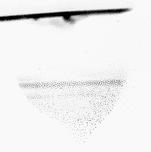
Fig 3b: Theoretical
charge per dust grain as a function of dust grain density.

The scaling of the mass of the dust particles in the balloon and the
effective charge on the grains is shown in figure 3. The
figure indicates that even for the highest dust densities, the mass
loading remains well below the target value of 1 gm/m2. To
address the issue of confinement, it may be possible to use
non-spherical dust (e.g., cylindrical or conical) in order to promote
strong coupling effects between the dust particles, thereby reducing the
need toward larger dust grain charges. Additionally, the use of
magnetic materials for the dust particle may sufficiently increase the
magnetic field within the balloon to allow the dust particles to be
confined, even with the lower charge.
Yet another scaling comes into play when the laboratory dusty cloud is
scaled to 30 km, which is the fact that the mass grows as the cube,
whereas the area grows only as the square. However, if Saturn is able to
confine its dust rings into a plane, it may be possible in the presence
of a large dipole magnetic field, to confine the dust into the
equatorial plane of the magnet. This thin dust plane would then have a
mass that scaled with the square so that the mass loading becomes a
constant independent of size. To explore this further, we have modified
the Spinning Terrella Experiment at NSSTC to study the dust trapping
behavior of a dipole magnet.
While the dust-filled magnetic balloon initially appears to satisfy the
mass loading criterion of < 1 gm/m2, numerous basic physics and
engineering issues must be addressed in order to demonstrate the
feasibility of these ideas. Some of the most critical areas for
investigation will be laboratory investigations of the confinement and
density distribution of dust within the magnetic balloon and
optimization of the choice of dust material (size, mass, coating,
magnetic properties, etc.). Nonetheless, the initial calculations
suggest that the addition of dust to the magnetic balloon can be a
viable technique.
Black Plasma Materials
Ions that absorb a great deal of the solar spectrum are ideal for plasma
sails. Part of the quiet acceptance of fluorescent lighting has been the
improvement in spectral color caused by innovative rare earth phosphors
that coat the inside of the tubes. These phosphors absorb the mercury
light and reradiate it efficiently at all wavelengths. If the same rare
earth materials can be incorporated into a dust particle, they may
provide a large improvement in solar spectrum opacity. Another
possibility are Polycyclic Aromatic Hydrocarbons (PAHs) which are
thought to occur naturally in nebulae and produce wide band absorption
features. These, and other advanced dust materials must be tested to
quantify their various strengths and weaknesses.
For this purpose, an experimental facility based on an innovative
technique referred to as electrodynamic balance has been under
development for a few years at the Marshall Space Flight Center. The
objectives are to carry out some basic experiments for understanding the
micro-physics involved in the formation, charging, growth, and
destruction of cosmic dust grains and to determine their extinction
coefficients (absorption and scattering characteristics) in various
astrophysical or planetary environments. The current work focuses on
various charging process of dust particles, and some preliminary results
been obtained and presented in various international meetings (e.g.,
Spann et al., 2000). Plans are under consideration for supplementing the
existing apparatus with optical and cryogenic facilities for measuring
the optical characteristics of levitated single dust grains of known
composition under controlled pressure/temperature environments. The
developing laboratory facility will be employed for measurements of
extinction coefficients and scattering characteristics of dust grains
considered to be suitable for development of the proposed propulsion
systems employing magnetic balloon concepts. The experimentally
determined data of optical characteristics of dust grains of desired
composition, size, and shape will permit radiative transfer modeling of
the solar radiation for accurate estimation of the total thrust on the
magnetic balloon in varying space environments.
A pictorial view of the laboratory facility at MSFC shown in the second
panel of figure 2, employs an innovative experimental technique
that permits suspension of single test particles in an electrodynamic
cavity (e.g., Davis, 1985; Spann, 1985). The experimental apparatus is
divided into three functional groups: the particle generator, the
particle container, and the radiation source and detector. The particle
generator utilizes inductive charging to produce a charged particle. A
solution of the particle to be studied is placed in a tube, sealed at
one end with a metal plate containing an orifice and injected at the
other with a piston. The particle container is known as an
electrodynamic balance or a quadrupole trap (Davis, 1985). An
alternating electric field is applied between a ring electrode and two
cap electrodes as shown schematically below. For a charged particle in
the trap volume, the time-averaged electric field, coupled with the
particle's inertia, causes it to be confined to a null point of lowest
potential. For experiments requiring vacuum, the particle generator is
removed and the trap is evacuated to p<10-5 torr. Once the
particle is trapped, it is balanced at the null point of the trap by
adjusting the potential between the top and bottom electrode.
Measurements of the parameters required for balancing and suspension of
the dust particle permits calculation of the charge, mass and size of
the particle.
Polarized tunable laser light sources detectors, combined with a
tungsten lamp blackbody light source will be used to measure the optical
characteristics of test dust particles in the visible and infrared
spectral range. Comparison of the measured scattered light as a function
of angle to that computed from Mie theory will be used to determine the
index of refraction and particle size. The Mie scattering program of
Wiscombe (1979) will be used to perform the data inversion in order to
determine the optical properties and size of the particle. The
computations of the intensity functions employing Mie theory, with
measurements of the scattered intensities as a function of angle, permit
calculations of the scattering phase matrix and the Stokes parameters
providing information about the angular distribution of radiation
scattered by the dust grain and the polarization characteristics.
Conclusions
It is still too early to judge whether a dusty plasma sail can survive
the rigors of space. Yet without a doubt, dusty plasmas push the
technology of mass loading into heretofore unexplored regimes of low
mass loading. If we are able to master the technology, we will have
found a new material that may someday power the fleets of interplanetary
spacecraft in the solar system.
References
- Davis, E. J., Electrodynamic Balance Stability Characteristics and
Applications to the Study of Aerocolloidal Particles, Langmuir, 1,
379-387 (1985).
-
Spann, J. F., and C. B. Richardson, Measurement of the Water Cycle of
Mixed Ammonium Acid Sulfate Particles, Atmos. Envir., 19, 819, 1985.
-
Spann, J. F., and M. M Abbas, Experimental determination of infrared
extinction coefficients of interplanetary dust particles, AGU Spring
Meeting, Boston, MA, May 1998.
-
Spann, J. F., M. M. Abbas, C. C.Venturini, and R. H. Comfort, Laboratory
study of charging mechanism and infrared extinction cross sections for
single interplanetary dusty plasma particles, Cambridge Symposium
Workshop, Cambridge MA, July 1998.
-
Spann, J. F., M. M. Abbas, C. C.Venturini, and R. H. Comfort,
Electrodynamic Balance for Studies of Cosmic Dust Particles, Physica
Scripta, 2000, to be published
-
Thomas, E., Jr,
"Observations of high speed particle streams in dc glow discharge
dusty plasmas",
accepted for publication in Physics of Plasmas.
-
Thomas, E., Jr. and Watson, M.,
"Charging of silica particles in an argon dusty plasma", Edward
Physics of
Plasmas, 7, 3194 (2000).
-
Thomas, E., Jr. and Watson, M.,
"First experiments in the Dusty Plasma Experiment (DPX) device",
Physics of Plasmas, 6, 4111 (1999).
-
Thomas, E. Jr.,
"Direct measurements of two-dimensional velocity profiles in direct
current glow discharge dusty plasmas",
Physics of Plasmas, 6, 2672 (1999).
-
Venturini, C. C., J. F. Spann, M. M. Abbas, and R. H. Comfort, A Dust
Grain Photoemission Experiment, AGU Spring Meeting, 2000.
-
Wiscombe, W. J., Mie Scattering Calculations: Advances in Technique and
Fast Vector Speed Computer Codes (1979), Document PB301388, NTIS,
Springfield, VA 22161.
Comments?r*bs@rbsp.info
(due to spammers, delete asterisk)






